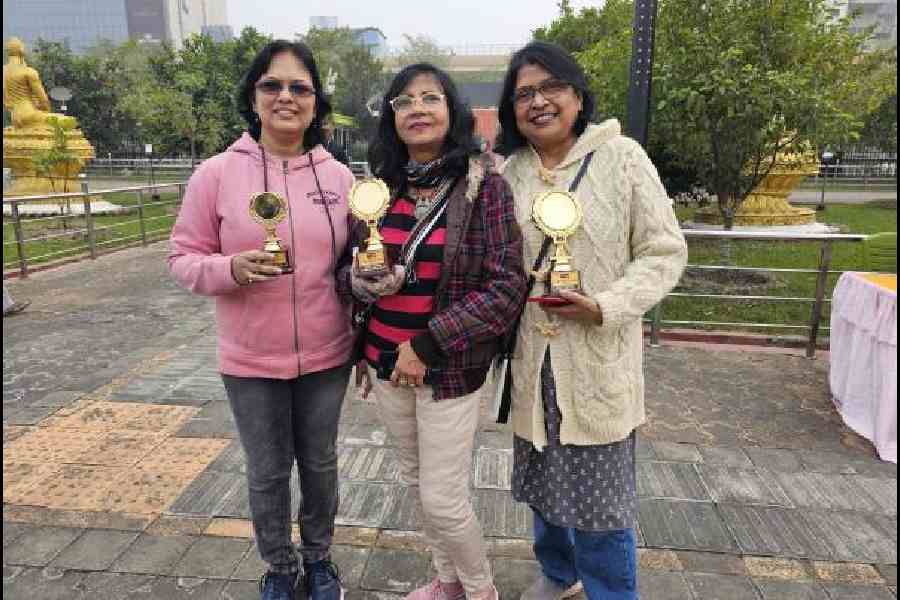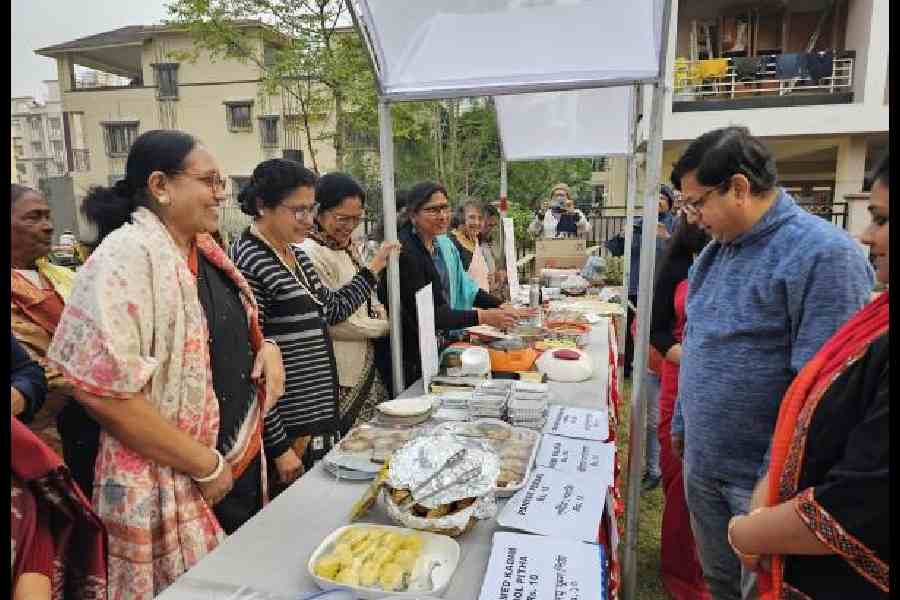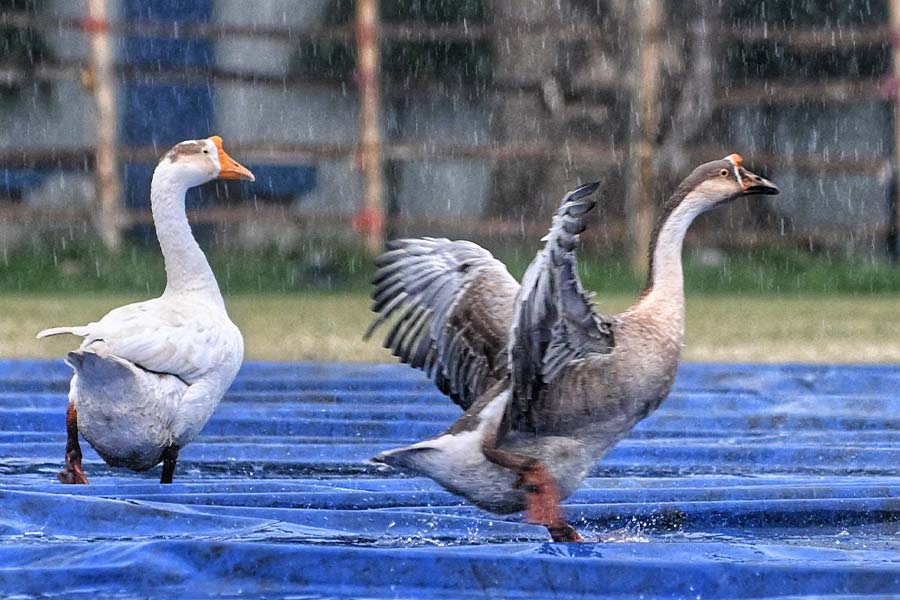CE Block, New Town
The weekends at the turn of the lunar month of Poush on the Bengali calendar brought to the fore the cooking skills of many a resident of the twin townships.
The Pithe Puli Utsab at CE Block in New Town was in its fourth year. “The cold seems to be lingering to provide the right ambience for your festival,” laughed Hidco managing director Debashis Sen, the chief guest at the food festival, addressing the 10 residents who had come with their stock of home-cooked traditional sweetmeats to sell at stalls set up on a local playground.
Of them, Aathrayee Das was a regular participant since the inaugural edition. “So are Nandini Chatterjee and Gopa Sarkar,” she said, pointing to her neighbours. She had brought 65 pots of Shahi Gur Rabri, of which 51 got sold within half an hour of opening. Daughter Adrita, an IT professional, was in charge of her cash box. “She helped me fill in the rabri in the earthen cups as well,” Aathrayee said.
Debashri Dutta Banik was a first-time participant. “I came to New Town in 2020 but could not take part earlier as my mother-in-law used to be ill and I teach in a school, which left me little free time. “This year, I decided to make some shoru chakli and sell it with a cabbage dish and jaggery. People seem to be loving it,” she said, with her fellow morning walker cum ladies club friend Abira Bhattacharya standing by to help out.

The Paneer Peraki sold by Mira Deb raised queries. The curious were enlightened by her son and assistant Ranajit. “There is a dumpling popular in east European countries called pierogi. Our neighbouring Bihar also has peraki stuffed with kheer, which is also called kheerer gujiya here. Since non-vegetarian pithes were stopped this year, we decided to make an inspired version of pierogi,” he said.
Mousumi Dey’s savoury patishapta and mildly sweet Mug Saoli were soon exhausted. “I had made gorgora peethe too. In fact, there was so much to do that I did not cook at home today. We made do with yesterday’s leftovers,” she smiled, standing next to her neighbour Sumana Banerjee who assisted her.
But the most enthusiastic participant, who was commiserated with and praised in equal measure, was Gopa Sarkar. The senior citizen, who used to be a cricketer, had fallen off the pillion seat of a two-wheeler after being hit in a road accident. Despite having trouble walking, she had made nine items, from Nonta Pithe and Niramish Machh Pithe, that looked like a fish, to Chusi Pither Payesh and Gurer Cake, which were listed on an illustrated chart.
Neighbours crowded around the stalls as soon as the opening took place with the enthusiasm of flies on a bowl of unattended syrup. “I did not have lunch today so I could have my fill of these delicious dishes,” said Rathin Mitra.
Secretary of the New Town CE Block Cultural Association Alok Das pointed out that though confectioners sold some common pithes these days, unlike their products people had more faith in the purity of the ingredients used by their neighbours. “If we want youngsters to move away from pizzas and burgers, we have to create opportunities for them to taste our traditional delicacies,” added Poulomi Roy, another organiser.
Swapnabhor
The pithe puli competition at Swapnobhor seniors’ club entered its fifth year. The club, which has a membership of close to 1,000, organises one for its members every winter. “This is a culinary art that our mothers were proficient in, which needs to be encouraged and passed down generations,” said a Hidco official as the participants lined up their home-cooked dishes on the respective tables.
As baul songs were performed on stage, the judges, Sudip Chatterjee and Mohd. Ali of Newtown Business Club, took a round, tasting each dish from the 10 participants.

Shahi Gur Rabri
Finally, it was Kumror Malpoa and Sujir Dudhpuli of AB Block resident Smriti Haoladar, that earned a score of perfect 10. Keya Saha’s patisapta was a close second, by a quarter of a point. Rupa Saha Ghosh’s Pakan Pithe, made of sweet potato, was another quarter of a point behind, securing third place.
“I think it was my Kumror Malpoa that earned me the top spot as the judges asked me about the process. The other participants too were surprised that pithe could be made out of pumpkin,” she said, adding that she had tasted the dish at her sister-in-law’s years ago.
BA Block
Around Makar Sankranti, the residents’ association of BA Block organised a pithe puli festival that saw people of all ages bring to the table their best homemade sweetmeats. And to gorge on the delicacies, not just BA Block residents, but also those from other blocks dropped in.
While pithe, puli and payesh were the star items, a few residents had prepared and sold some non-vegetarian fare as well. About 20 stalls were put up in the specially decorated venue, the ground next to the community hall, which was chock-a-block with visitors.
“There is something irresistible, even intoxicating, about Bengal’s pithe and puli,” said Bhakti Ghosh, 85. “When I heard about the festival, my heart leapt with joy and despite my old age and frail body, I decided to be a part of this. I feel particularly happy that many young women and men have put up stalls. This underscores the fact that Poush Parbon and pithe puli still excite us,” said the former teacher of Bengali.
Shahi Gur Rabri
Ingredients
Milk 1.5 litres (half litre for chhana)
Sugar 4 tbsp
Gur as per taste (patali/ jhola)
Milk powder 100g
Condensed milk ¾ tbsp
Method
Boil one litre milk and let it reduce to half. Add sugar. At first, let the chhana cool. Then crumble it and mix with milk powder. Crumble a bit of patali gur (or a bit of jhola gur) and add. When the milk is reduced to more than half, add the chhana mixture and gur (preferably jhola) and stir continuously. After the rabri thickens, add the condensed milk for a rich, creamy texture. Pour into small containers and top each portion with grated coconut and jhola gur. Chill before serving.
Recipe by Athrayee Das






